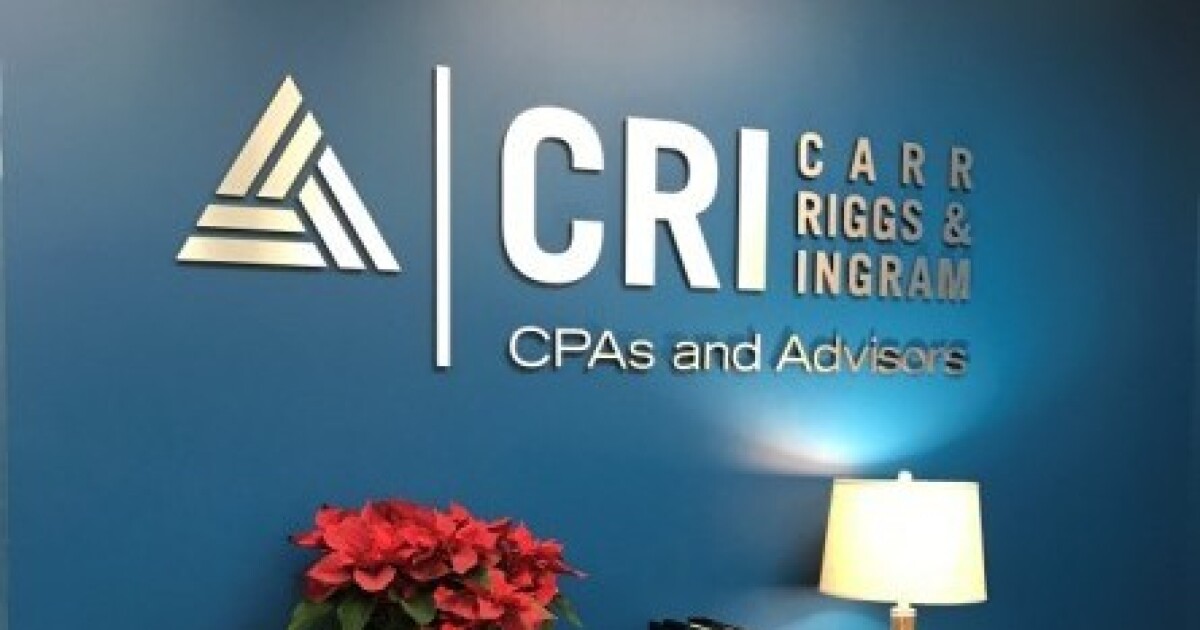Carr, Riggs & Ingram, a Top 25 Firm based in Enterprise, Alabama, has added CapinCrouse, a Regional Leader based in Indianapolis, effective Jan. 17, 2025.
The deal is CRI’s biggest merger in its history, and the first since it received outside investment last November from Centerbridge Partners and Bessemer Venture Partners.
CapinCrouse focuses on exclusively serving nonprofits, such as faith-based organizations and private colleges. The merger will add 40 partners, 185 professionals and 15 offices to CRI, which has 437 partners and 2,304 staff
After the outside investment, CRI split its attest and non-attest practices, as is common when accounting firms receive private equity or venture capital funding. Carr, Riggs & Ingram, L.L.C., as an independent licensed CPA firm, is providing assurance, attest and audit services. CRI Advisors, LLC (including its subsidiary entities) operates as a separate legal entity, providing clients with tax and business consulting services.
“This merger represents an exciting milestone in our firm’s history and a significant advancement for both CRI and CapinCrouse,” said CRI Advisors LLC chairman Bill Carr in a statement Tuesday. “We have previously invested in firms that specialize in serving faith-based organizations and private colleges. With the addition of CapinCrouse, CRI is now positioned to become the leading national provider in these vital markets. By combining our strengths, we will enhance the value we offer and greatly expand our national geographical presence. We are proud to welcome CapinCrouse to the CRI family.”
Financial terms of the deal were not disclosed. CRI ranked No. 24 on Accounting Today‘s 2024 list of the Top 100 Firms, with $455.36 million in annual revenue. CapinCrouse ranked No. 27 on Accounting Today‘s Regional Leaders list of the Top Firms in the Great Lakes region, with $35.51 million in annual revenue.
“We are very pleased to join CRI,” said Fran Brown, Managing Partner of CapinCrouse. “For over 50 years, our focus has been on providing innovative service to nonprofit organizations whose outcomes are measured in lives changed. CRI’s commitment to client service, respect, and integrity is an excellent fit with our mission and firm culture. We will continue to operate under the CapinCrouse brand and are excited to now have access to more offerings and resources to further drive exceptional client service.”
Koltin Consulting Group CEO Allan Koltin advised both firms on the merger. “It is interesting to note that this is CRI’s biggest M&A deal in its history, and it comes on the heels of their private equity deal with Centerbridge Partners and Bessemer Venture Partners,” he said in a statement. “CapinCrouse, a top 125 firm nationally, is viewed by many as the preeminent firm in the country when it comes to the audit and related advisory services of nonprofits and religious organizations. My intuition suggests that going forward, we will see CRI expanding its geographic reach nationally by combining with more top 200 firms.”
Last August, CRI added ProSport CPA, a firm in New Kent County, Virginia, offering tax and accounting services within the sports and entertainment niche. In 2023, CRI expanded into Oklahoma by adding Stanfield + O’Dell PC, a firm in Tulsa. CRI expanded to South Carolina in 2022 by adding Lanning Group LLC, a firm based in Mount Pleasant in the Charleston suburbs, and expanded in Florida by adding Alonso & Garcia, a firm in Miami. It expanded that year in Florida by adding Travani & Richter in Jupiter, and in Texas by adding Pharr Bounds LLP in Austin.
In 2022, CapinCrouse acquired the Global Center for Nonprofit Excellence.


 Personal Finance1 week ago
Personal Finance1 week ago
 Economics1 week ago
Economics1 week ago
 Economics5 days ago
Economics5 days ago
 Economics1 week ago
Economics1 week ago
 Economics5 days ago
Economics5 days ago
 Finance5 days ago
Finance5 days ago
 Economics5 days ago
Economics5 days ago
 Economics3 days ago
Economics3 days ago












